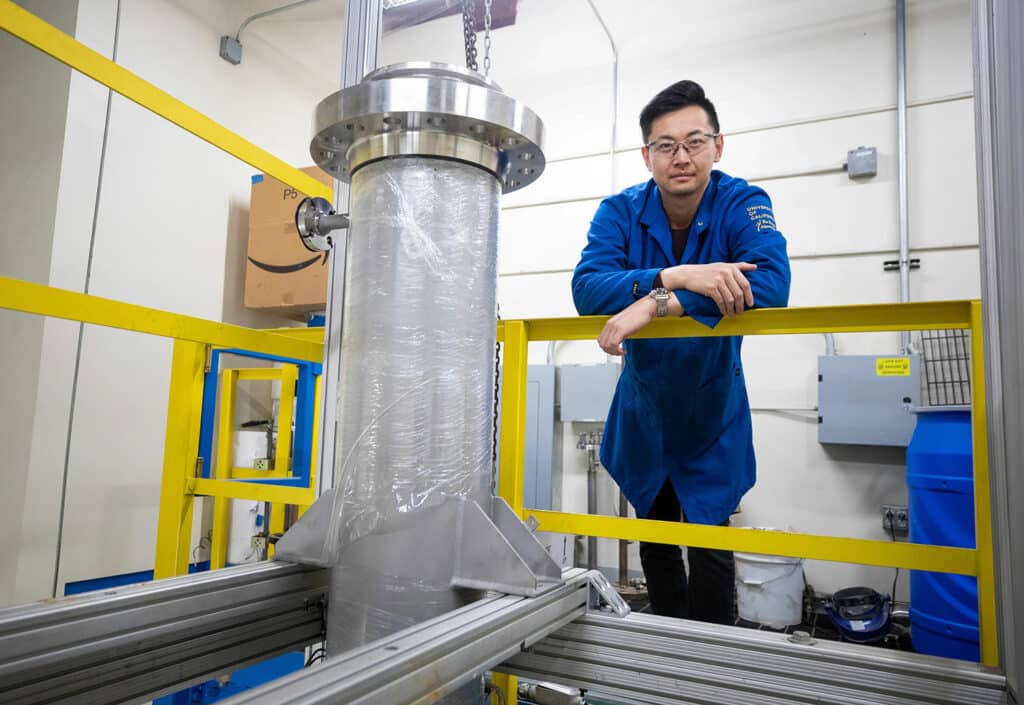The process of breaking down plant matter has always been a challenge in making fuel from plants. A new study finds that introducing a simple, renewable chemical to the pretreatment step of sustainable aviation fuel (SAF) made from waste wood biomass can potentially make biofuel production cost-effective and carbon neutral.
While SAF may not be a perfect green solution to aviation, it is definitely a step in the right direction. SAF produces up to 3% more energy while burning cleaner, with heavily reduced sulfur and particulate emissions. Also, it eliminates the entire emissions cost of the oil extraction and refining processes.
SAF doesn’t rely on food crops as feedstock but instead uses feedstocks like wood residues, sugarcane bagasse, corn stover, and other cheap, abundant waste products.
A research study conducted by UC Riverside researchers highlights the challenges of extracting carbon for fuel from biomass. The problem has been lignin, which is a tough and resilient structural component found in plant cells.

Lignin makes it difficult to extract carbon for fuel from biomass, especially when dealing with harder woods. As a result, many operations end up burning the lignin for process heat and power, which is economically viable but not environmentally sound.
Now, the UC Riverside team has come up with a promising solution. They have developed a pretreatment that adds tetrahydrofuran (THF) to water and dilute acid during biomass pretreatment. This pretreatment has the potential to significantly improve overall efficiency and add lignin extraction capabilities. THF itself can be made from biomass sugars.
According to the study, using THF pretreatment with corn stover can yield up to 51.8 gallons (196 L) of gasoline equivalent per ton of dry feedstock, which is 18% more than the conventional process. However, if you use poplar wood with its higher lignin content, the yield can be as high as 75.9 gallons (287 L) of gasoline equivalent per ton of dry feedstock, nearly twice as much as corn stover can produce. That’s certainly a lot more aviation bang for your waste biomass buck.
The THF pretreatment chemical is not only cheap but also easily obtainable, as it can be produced from the same sugars that SAF operations are already processing.
According to the Department of Energy, up to a billion tons of biomass could be used annually to manufacture biofuels and bioproducts in the United States alone, which could displace 30% of the country’s petroleum consumption and create new jobs. Using a heavier, denser feedstock like hardwood poplar in a CELF (co-solvent enhanced lignocellulosic fractionation) biorefinery can yield greater economic and environmental benefits than less carbon-dense corn stover.
The UC Riverside researchers demonstrate that sustainable aviation fuel can be produced at a break-even price as low as $3.15 per gallon of gasoline equivalent, which is significantly lower than the current average cost of a gallon of jet fuel in the United States.

The paper shows that utilizing lignin can have a positive impact on the overall economics of a biorefinery while keeping the carbon footprint as low as possible. In older biorefinery models where biomass is cooked in water and acid, the lignin is mostly unusable for anything other than its heating value.
However, in the CELF biorefinery model, better lignin utilization is proposed, along with the production of renewable chemicals that can be used as building blocks for bioplastics and food and drink flavoring compounds. These chemicals can take up some of the carbon in the plant biomass that would otherwise not get released back into the atmosphere as CO2.
“Lignin utilization is the gateway to making what you want out of biomass in the most economical and environmentally friendly way possible,” said UC Riverside Associate Research Professor Charles Cai. “Designing a process that can better utilize both the lignin and sugars found in biomass is one of the most exciting technical challenges in this field.”
“I began this work more than a decade ago because I wanted to make an impact. I wanted to find a viable alternative to fossil fuels, and my colleagues and I have done that,” Cai said. “Using CELF, we have shown it is possible to create cost-effective fuels from biomass and lignin and help curb our contribution of carbon emissions into the atmosphere.”
Journal reference:
- Bruno Colling Klein, Brent Scheidemantle, Rebecca J. Hanes, Andrew W. Bartling, Nicholas J. Grundl, Robin J. Clark, Mary J. Biddy, Ling Tao, Cong T. Trinh, Adam M. Guss, Charles E. Wyman, Arthur J. Ragauskas, Erin G. Webb, Brian H. Davison, and Charles M. Cai. Economics and global warming potential of a commercial-scale delignifying biorefinery based on co-solvent enhanced lignocellulosic fractionation to produce alcohols, sustainable aviation fuels, and co-products from biomass. Energy & Environmental Science, 2023; DOI: 10.1039/D3EE02532B
